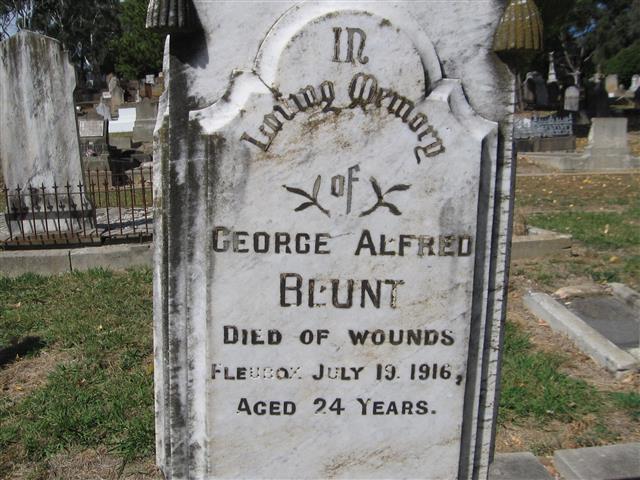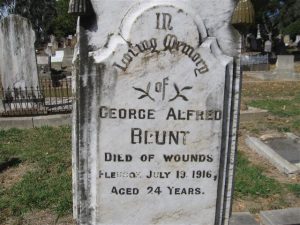George Alfred Blunt was born in Lucknow in 1891, the fifth of ten children born to Charles Blunt and his wife Fanny (nee Agland). The Blunt family has enjoyed a long association with the village of Lucknow: George’s grandfather, Charles snr, was the licensee of the Victoria Hotel during the 1860s, and later the Commercial Hotel; in 1898 George’s father, Charles jnr, opened a butcher’s shop on the corner of Newman Street and Main Road. Charles jnr was a councillor on Canobolas Shire Council, and its president for many years. He was also a long-time warden at St John’s Anglican Church, a member of the Oddfellows and the Society of Foresters, and a shareholder in the New Reform Gold Mining Company.
George and his siblings were educated at Lucknow Public School and, as a youth, George served in the 9th Light Horse Orange Troop.
On Wednesday, 18 August 1915, Captain Eade of the Defence Department opened a new recruiting depot at the Drill Hall in Lords Place. George was among the 42 men who presented themselves to Dr Freyer for medical examination, and was one of only 14 who were declared fit for service.
At 10am on Monday, 30 August 1915, a large crowd gathered at the Drill Hall to join George and 23 other locals as they left for Lithgow training camp. The Orange Town Band led the procession to the railway station where the Mayor, Ald. McNeilly addressed the crowd and the men were presented with cigarettes and pocket testaments.
George embarked for overseas service on 8 March 1916 and was taken on strength with the 55th Battalion at Ferry Post in Egypt on 20 April 1916.
On 2 May 1916 Private Blunt was promoted to Corporal; he was appointed Lance Sergeant before promotion to the rank of Sergeant on 31 May 1916. On 19 June 1916 he embarked from Alexandria on HT Caledonian to join the British Expeditionary Force in France.
One month later, in the afternoon of 19 July 1916, Sergeant Blunt was hit by a shell while in the trenches at Fleurbaix, on the opening day of the Battle of Fromelles. Severely wounded, George was transferred to the 1st Canadian Casualty Clearing Station at Bailleul, where he died of his wounds. He was buried in the nearby Bailleul Communal Cemetery Extension. George was one of the 1,917 deaths that resulted from the disastrous Battle of Fromelles.
George Alfred Blunt is commemorated on the Holy Trinity Church Honour Roll, the Lucknow Public School Honour Roll, the World War I Roll of Honour on the southern face of the Orange Cenotaph and on panel number 160 on the Roll of Honour at the Australian War Memorial in Canberra. His name also appears on a commemorative plaque at the Orange Cemetery, Church of England Section A, Grave 369/373.
At Lucknow Hall on Sunday, 5 February 1920, the Reverend EA Homfray, unveiled a memorial tablet in memory of George Alfred Blunt and Arthur Gordon (‘Bun’) Ash. He claimed the oak tablet would remind those in years to come of what the two brave Lucknow boys had done, and the sacrifice they had made in the world’s greatest war.
In 1923 the Anzac Memorial Avenue of trees was planted along Bathurst Road to commemorate fallen WWI soldiers. A tree was planted in honour of Sgt George Alfred Blunt; it was donated by his father, Chas. Blunt. Very few of the trees are still standing today.
In September 1964 a tree was planted in George’s memory in front of Lucknow Public School. It was one of thirteen trees planted to commemorate those ex students and teachers who had died during WWI and WWII.
Leader, 3 September 1915, p. 5.
An Enthusiastic Gathering


